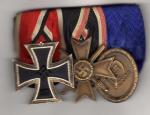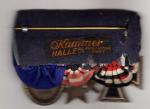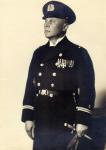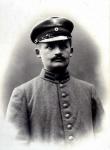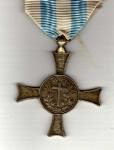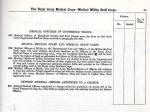-
Posts
2,143 -
Joined
-
Last visited
-
Days Won
10
Content Type
Profiles
Forums
Blogs
Gallery
Events
Store
Everything posted by Odulf
-
I picked up this very interesting studio portrait, and I would appreciate some educated opinions... I conclude the dating at 1933/34, just before introduction of the German Third Reich eagle. Puzzeling are the anchors over the tapes on the lower sleeves, for which I cannot find any indication in my reference books (probably Zahlmeister?). On the right breast he is wearing the Turkish War Medal. His medal bar shows two medals and two ribbons... The medals are: Iron Cross 2nd cl. (1914) and Dienstauszeichnung (NCO?) Kreuz; the ribbons indicate: ? and Turkish War Medal (Gallipoli Star). I think, this man served as an NCO in the great War and he remained in the Reichsmarine, to be finaly promoted in the late 1920s or early 1930s. Your ideas please....?
-

Prison garment?
Odulf replied to Monsieur Hulot's topic in Great Britain: Militaria: Badges, Uniforms & Equipment
Definetely Government Issue clothing. On the trousers I see a long pocket stitched on the leg, to fit a pencil, rule, or any other tool. Could also be simple working rig for an official or military yard/workshop, juvenal institute, or such like. I think that I may have seen something similar in the Chatham Dockyards museum, with a white woolen jacket with toggles. -
I agree, seen heaps of silver medals (BWM & others) in the 60s & 70s, at dealers' shops. The groups were bought at scrap silver value..., the brass metal was inome! There was no interest in heroes... Run of the mill, it was, and gramps' medals were cashed for a new coat. It was the ignorance of small folk, and the lack of research that brought this to effect. The suspention bars (I have taken home kilos of these) went to trash, but some may have survived. In other cases families may have cut of the hardware, and left the bar lingering. Who wants bars with ribbons? I still have a lot left...? Now, it's no use crying over spilled milk, and how sad, or how else. Facts are facts, and plod on...
-

Netherlands Dr. Ilarie (Hilarion) Mitrea
Odulf replied to Carol I's topic in Northern European & Baltic States
Information from the Dutch East Indies Army Annual Lists reveals: H. Mitrea (born 1842) 1893 Penisioned without promotion. His promotion: 28-05-1889 Dirigerend Officier van Gezondheid 2e klasse [Directing Medical Officer, 2nd class], equaling the rank of Major 13-08-1878 Officier van Gezondheid 1e klasse [Medical Officer, 1st class], equaling the rank of Captain 31-08-1871 Officier van Gezondheid 2e klasse [Medical Officer 2nd class], equalling the rank of Lieutenant 27-03-1869 Officier van Gezondheid 3e klasse [Medical officer 3rd class], equalling the rank of ensign His postings between 1871 and 1877: 1871 Mr.Cornelis (Java) 1872 Southern and Eastern departmenst of Borneo 1873/75 Southern and Eastern departments of Borneo, Bara-bei-ie 1876 Southern and Eastern departments of Borneo, Moera Teweh 1877 Atjeh In 1879 he finished his medical training and qualified as a Medical Doctor. Medals & Decorations: in 1877 he received the Expeditions Cross (probably for his service in Atjeh, thus with the clasp Samalangan 1877) Later, his other decorations are mentioned: Rumanian Order of the Crown 3rd cl. French Medal for the expedition to Mexico Dutch Officers'Long service Cross, with the digit XV (for 15 yrs)and 1890 with de tigit XX (for 20 yrs) -
-

Netherlands Dutch Naval Service Medal Info Needed
Odulf replied to jshorter's topic in Northern European & Baltic States
Yes Jason, it is a quite common medal, all Naval personnel with some years of service have this medal; to my opinion it is a rather superfluous medal. -

Netherlands Dutch Naval Service Medal Info Needed
Odulf replied to jshorter's topic in Northern European & Baltic States
The official name is: Marine Medaille (Naval Medal) Instituted: 18-01-1985, as a token of appreciation for long operational service, for all naval personel on active service on 18-01-85 or after this date, who served a minimum of 36 months, consisting of periods of minimal 30 in a row, on board of a ship at sea, with a Naval Air Squadron, with an operational unit of the Royal marines, and who served a minimum of 6 months on board of a vessel in the STANAVFORLANT, STANAVFORCHAN, STANAVFORMED, or with Matchmaker, or who served a minumum of 6 months with a Naval unit in the Dutch West Indies, the previous Dutch New-Guinea, or Dutch Surinam, or who served with a unit of the Air Force or Army in any of these areas. et., etc. This is not a Long Service Medal, but a Naval General Service Medal. -

Italy ITALY VATICAN MENTANA CROSS ENGRAVINGS?
Odulf replied to Alpha Draconis's topic in Southern European & Balkan States
Interesting, here is mine (2647 - 1 de L). Obviously the French 1st Regt. of Foot had their Crosses engraved with the Service number and the number of the regiment. -
Today I received this most interesting postcard size studio portrait from a photographer in Constantinopel. A young German sailor with his Iron Cross 2nd class. The translation of the script on the back is: In commemoration of the war-year 1915. Dedicated to my dear aunt Helene. Constantinopel 27 May 1915. He was probably decorated before May 27th, 1915, for one of the Naval actions in the Black Sea or at Gallipoli. This makes me wonder how many of the men on board these ships received the EK2. Does any one here have a clue?
-
The Militia were surplus parttime troops. As a result ot the Cardwell Reforms in the 3rd quarter of the 19th Century the Army, and in particular the Infantry Regiments, underwent a reconstruction and reformation (see Wikipedia). Afterwards, most Infantry Regiments consisted of 2 Battns with professional soldiers, one for home service and one for overseas service. Nearly all regiments had Militia Battns, a kind of Regimental reserve pool of volunteers, ex-professionals, etc. For instance, The Royal Fusiliers (City of London Regiment), around 1900, was a large Regiment (most regiments had 2 Battalions, but the RF had 4 regular battalions (numbered 1st, 2nd, 3rd, 4th Battn.), plus another three Militia Battns. 5th Batt. = The Royal Westminster Militia 5th Batt. The Royal London Militia 6th batt. The Royal South middlesex Militia.
-
Three metal insignia of the P.A.T. From left to right: - Cap badge: 48 mm, Crude cast white metal with stitched-on khaki backing, diam. . - Sleeve badge: 55 mm, Stamped copper sheet, bend, with two vertical placed loops for suspension, tinned, with dull red paint. - Purpose undefined: 50 mm, Stamped copper alloy metal These badges originate from the "Bersiap" period, between Oct. 1945 and early 1946. After the Japanese Army, which occupied the Dutch East indies, surrendered there was a vaccum of power, before the first Allied troops arrived from India. All Dutch Army men were either in POW Camps in Burma, Thailand or Japan, so there were no authorities with muscle to full the gap. During this period rioting Indonesian nationalists saw their chance to grasp power, flared by nationalist radio, and they started a furious riot to kill all enemies. In fact they killed many inocent Dutch women, children who were just release by the Japs from inprisonment, an their personnel (servants) who remained loyal to the Dutch. A storm of blind hated raged the Dutch Eas Indies, and many civilians, men, women and children, fled back into their prison camps under the protection of the japanese Army. The rioters also killed many Japanese soldiers, mainly for their weapons. It lasted weeks before Allied troops, mainly Indian Battalions, reached the outskirts of Indonesia to restore order, and months and much reasoning before order was restored. About 5500 people fell vicim to this riot; most murderers escaped and became celebrated heroes of the Republic. The Chinese in the Dutch indies, have Always formed a secluded but much valued community [not unlike the Jews in Europe] with their own culture, language, morals, but also in certain cases with directions from the home land. They were also picked by the nationalists as "unwanted elements" in the new to build independent State of Indonesia. Unfortunately i have no figures about the victims amongst the Chinese, due to this period of violance. The Pan An Tui was a Chinese Security Corps, financed by the Chinese Community in the Dutch East Indies. Members were local Chinese volunteers (trained and armed by the Dutch Army) to protect their community against rioters. A small unit of female uniformed volunteers were active as domestic, social and medical aids. [special thanks to Mr. A.J. van Veen!]
-

NSDAP Reichsparteitage
Odulf replied to Odulf's topic in Germany: Third Reich: Research, Documentation & Photographs
Good show Pagan!



